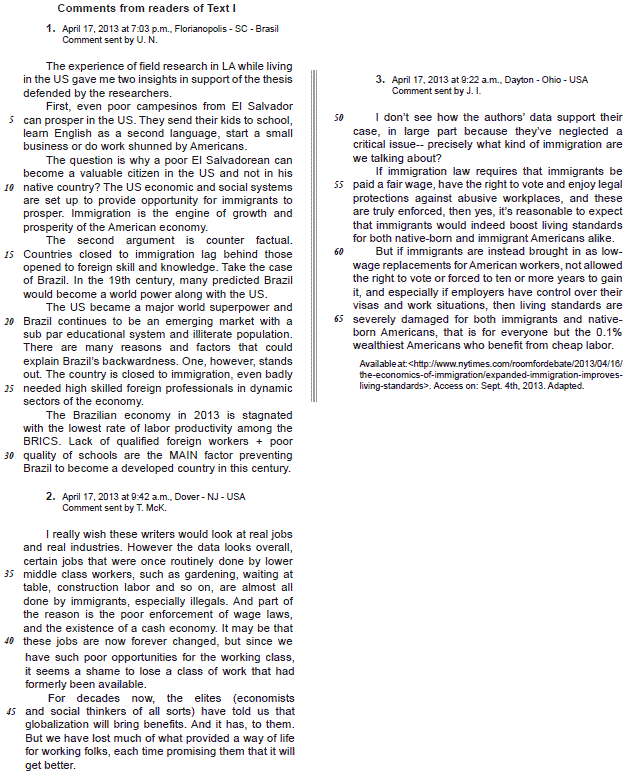Questões de Língua Inglesa da Fundação CESGRANRIO (CESGRANRIO)
Lista completa de Questões de Língua Inglesa da Fundação CESGRANRIO (CESGRANRIO) para resolução totalmente grátis. Selecione os assuntos no filtro de questões e comece a resolver exercícios.


- A. as a result of
- B. because of
- C. except for
- D. despite
- E. due to


- A. other (Text I, line 23) refers to impacts (Text I, line 23).
- B. these (Text I, line 33) refers to programs (Text I, line 31).
- C. them (Text II, line 46) refers to working folks (Text II, line 48).
- D. it (Text II, line 48) refers to way of life (Text II, line 47).
- E. these (Text II, line 56) refers to workplaces (Text II, line 56).


- A. cutting-edge (Text I, line 17) and vanguard convey opposite meanings.
- B. further (Text I, line 25) and additional have equivalent meanings.
- C. actually (Text I, line 32) and nowadays are synonyms.
- D. boost (Text I, line 41) and raise are antonyms.
- E. sub par (Text II, line 21) and extraordinary express similar ideas.


- A. even poor campesinos from El Salvador can prosper in the US (lines 4-5)
- B. many predicted Brazil would become a world power (lines 17-18)
- C. There are many reasons and factors that could explain Brazils backwardness (lines 22-23)
- D. It may be that these jobs are now forever changed (lines 39-40)
- E. "globalization will bring benefits (line 46)


- A. established introduced
- B. ignored incorporated
- C. organized discarded
- D. forbidden eliminated
- E. created returned


- A. contrast
- B. solution
- C. hypothesis
- D. addition
- E. explanation


- A. a country becomes a superpower when it takes up in its workforce more qualified immigrant professionals and rejects unskilled workers.
- B. low-skilled immigrants to the US find more opportunities to prosper than they would in their countries of origin.
- C. Brazil is still an emerging country because it has closed its doors to immigration of unskilled workers from South American countries.
- D. Brazil offers its immigrant population appropriate educational conditions to become valuable citizens.
- E. Brazils illiterate population and El Salvadors immigrants to the US have no opportunity to prosper and help the countries economic growth.


- A. author of Comment 1, U.N., has a view that is contrary to that manifested by the author of Text I in terms of a countrys economic standards.
- B. author of Comment 2, T. McK, supports the argument on the relation between economic growth and foreign workforce exposed in Text I.
- C. author of Comment 1, U.N., and the author of Comment 3, J.I., side with the author of Text I about immigration and economic development.
- D. authors of Comments 2 and 3, T. McK and J.I., respectively, oppose the view on the relation between economic development and rates of immigration expressed in Text I.
- E. three commentators agree with the perspective on the importance of immigration defended by the author of Text I.
 In Text I, we understand that Lu
In Text I, we understand that Lu
- A. went to war when he was 30.
- B. became a veteran before he started teaching at MIT.
- C. has first trained people to be engineers and will soon get a medical degree.
- D. is both an engineer and a medical doctor and now works as an MIT professor.
- E. started medical school at MIT at 30.
 In Text I, Lu describes himself in a biology lab as
In Text I, Lu describes himself in a biology lab as
- A. methodic
- B. relaxed
- C. clumsy
- D. paranoid
- E. unconscious


